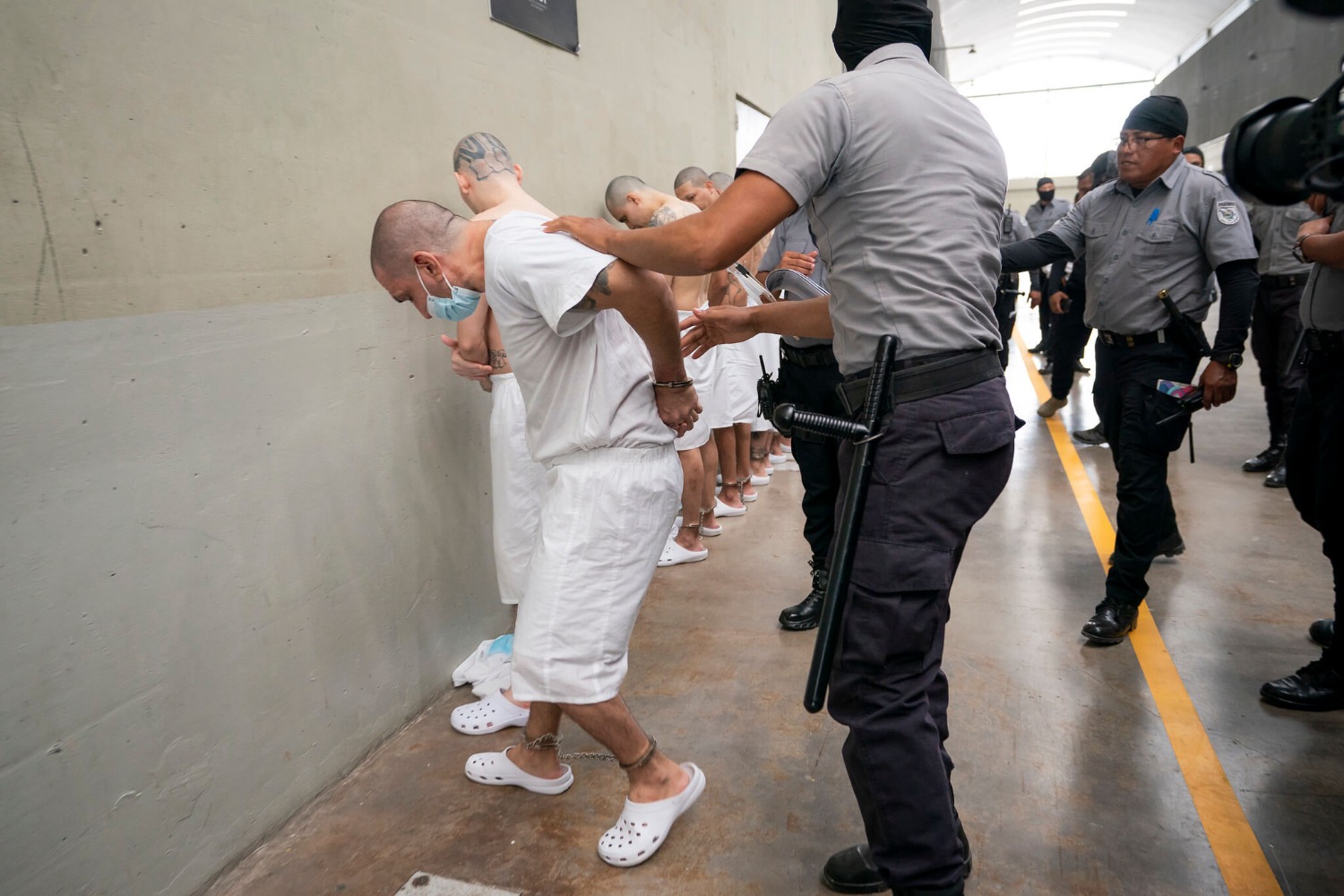The Final Day of Trump’s New York Trial: A Photo Essay
A historic day in photos.
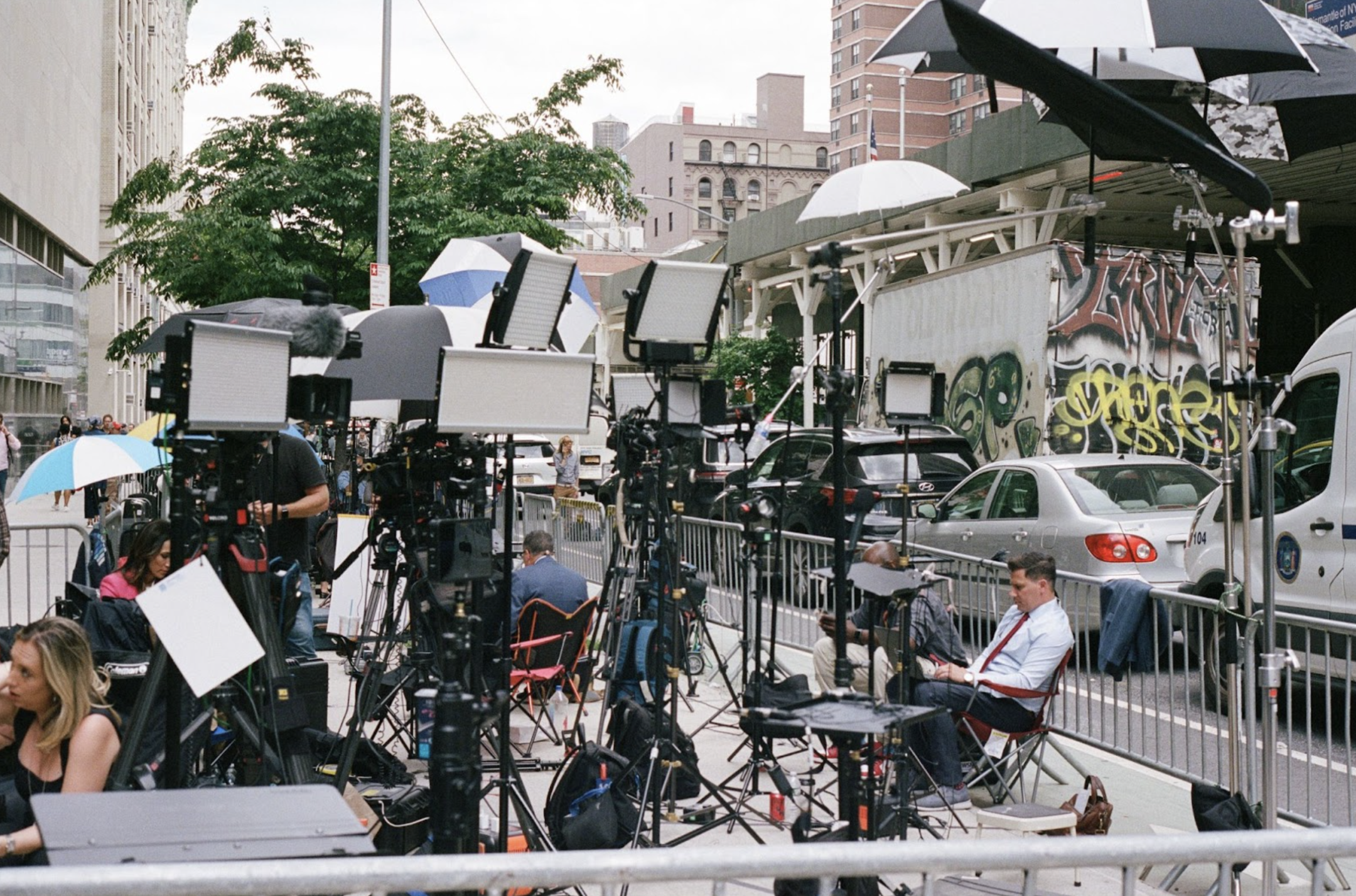
Published by The Lawfare Institute
in Cooperation With

Thanks in part to the kidnapping of Charles Lindberghs’ baby, and the media circus that surrounded the ensuing trial in 1935, New York state has some of the most restrictive rules in the country when it comes to media coverage of court proceedings.
Audio and video streaming of Donald Trump’s New York criminal trial was strictly verboten. But outside the courthouse and across the street at Collect Pond Park—which became a de facto staging ground for protests, idle press, live broadcasts, and all manner of shenanigans—just about everything was fair game.
And it’s a good thing, too. After writing well over 100,000 words with my Lawfare colleagues in our dispatches spanning the trial’s five weeks, the scene outside the New York Supreme Court at 100 Centre Street remained largely indescribable.
It was a circus, a New York burlesque. It was chaotic and messy, yet there was also a rhythm, as line sitters and other journalists from less-resourced outlets arrived at ungodly hours, slowly replaced and added to by the press, protesters, passersby, and hangers on. Some characters I saw nearly everyday at Collect Pond Park, and others came and went as they pleased.
That rhythm came to an abrupt end on May 30, when, from the press overflow courtroom, I heard the jury’s foreperson say the word “guilty” 34 times, one for each felony count of falsifying business records. Feeling stunned and already a touch nostalgic, I grabbed my camera, descended the courthouse’s 15 flights of stairs, walked out the revolving front door, and started snapping photographs.
(All photos were taken on May 30, 2024 by Tyler McBrien; CC BY-NC-ND 4.0)
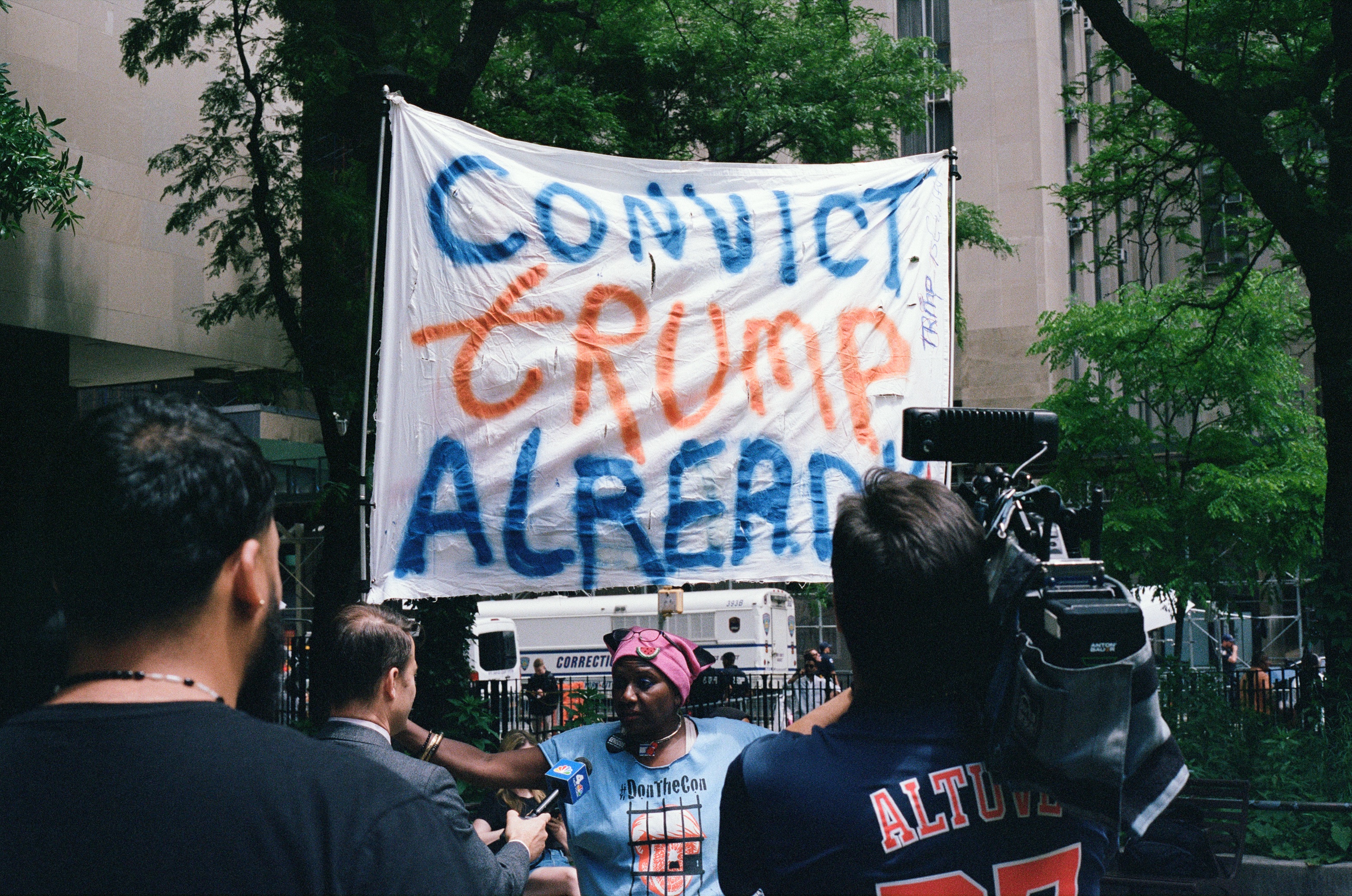
Newscasters interview a protester with a banner that reads, “CONVICT TRUMP ALREADY.” This protester was a fixture at Collect Pond Park for much of the trial.
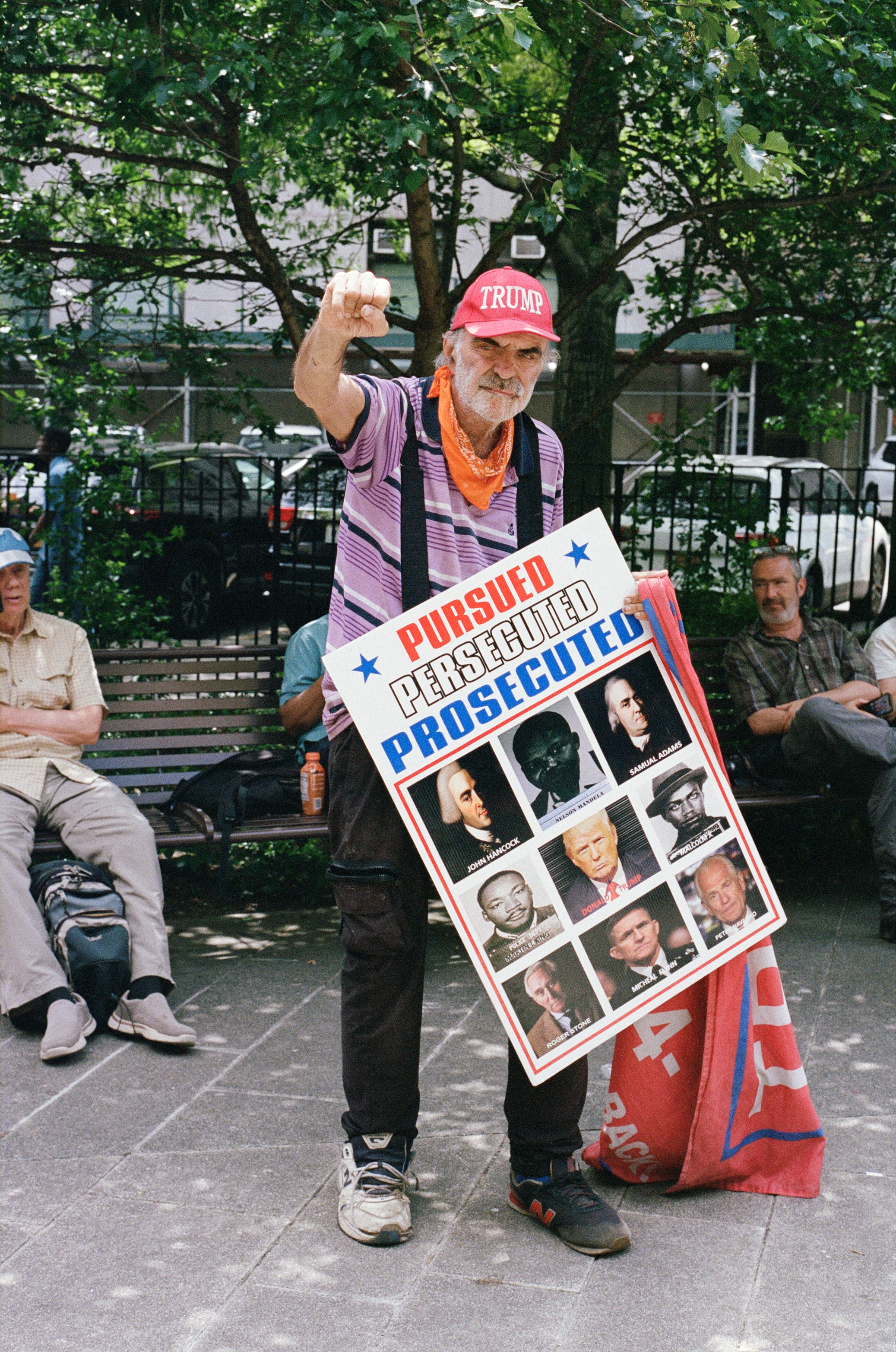
A protester holds up an alliterative sign that reads “PURSUED PERSECUTED PROSECUTED,” with a photo of Donald Trump and other famous figures whom the man must think fit the same three-part criteria: John Hancock, Nelson Mandela, Samuel Adams, MLK Jr., Malcolm X, Roger Stone, Michael Flynn, and Peter Navarro.
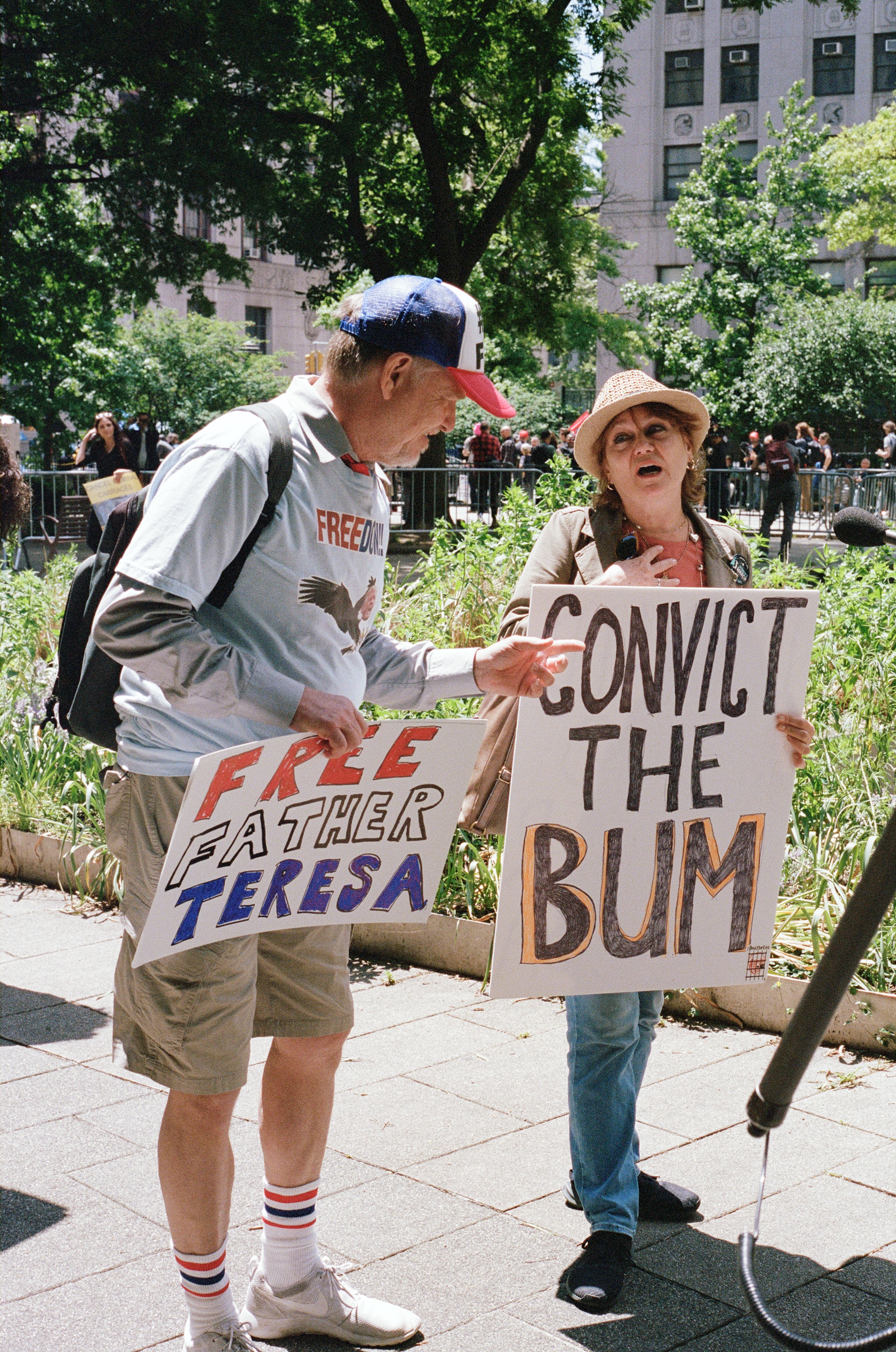
At first glance, the photo appears to depict dueling protesters with contradicting signs. But further research revealed that the man on the left was a comedian paid by Jimmy Kimmel. Paid crisis actors, much?
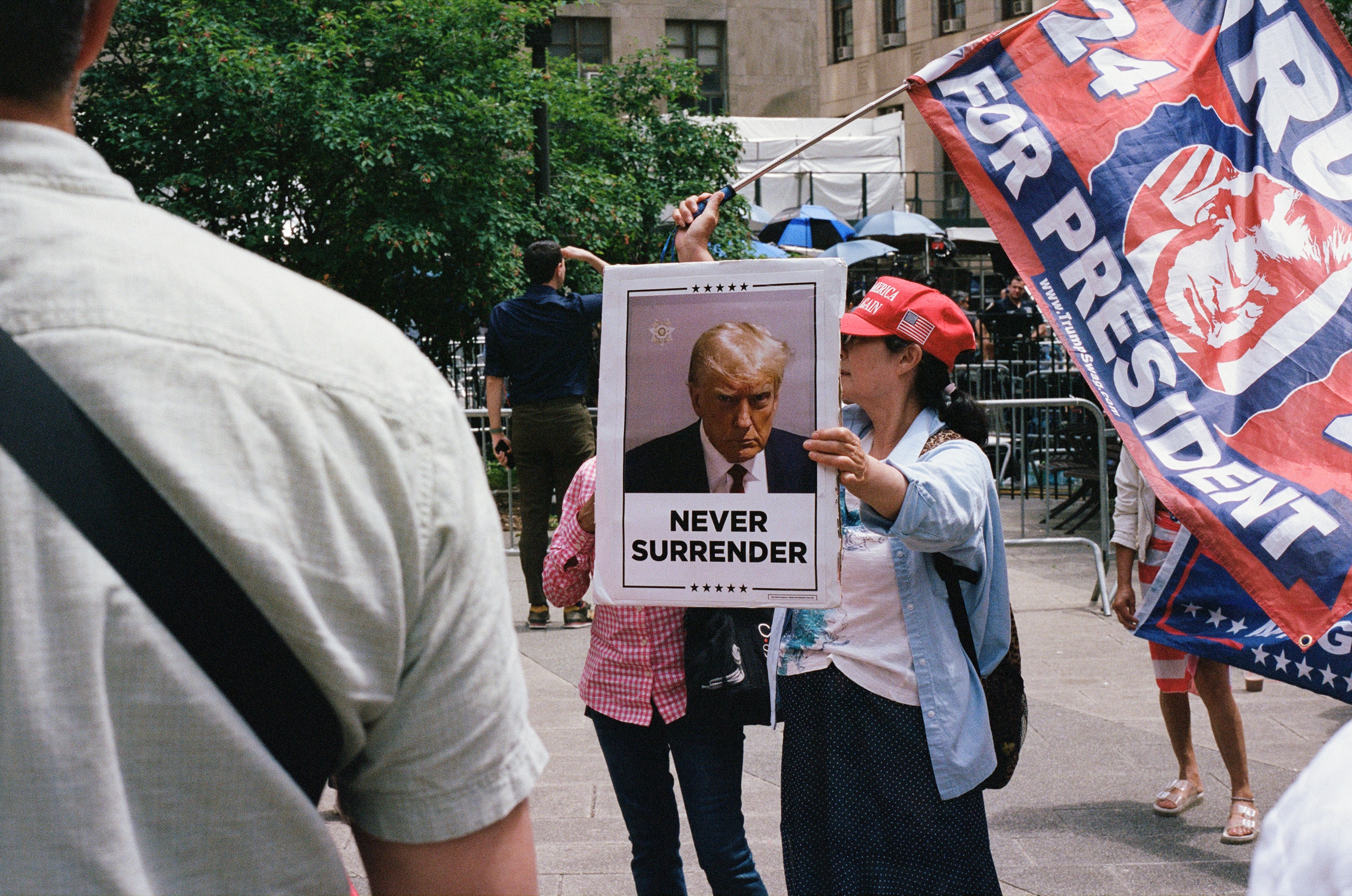
Yet another protester holds up a sign that reads “NEVER SURRENDER” with Trump’s Fulton County mugshot, a visual reminder that the former president’s legal woes are far from over—even now that his New York trial has concluded.
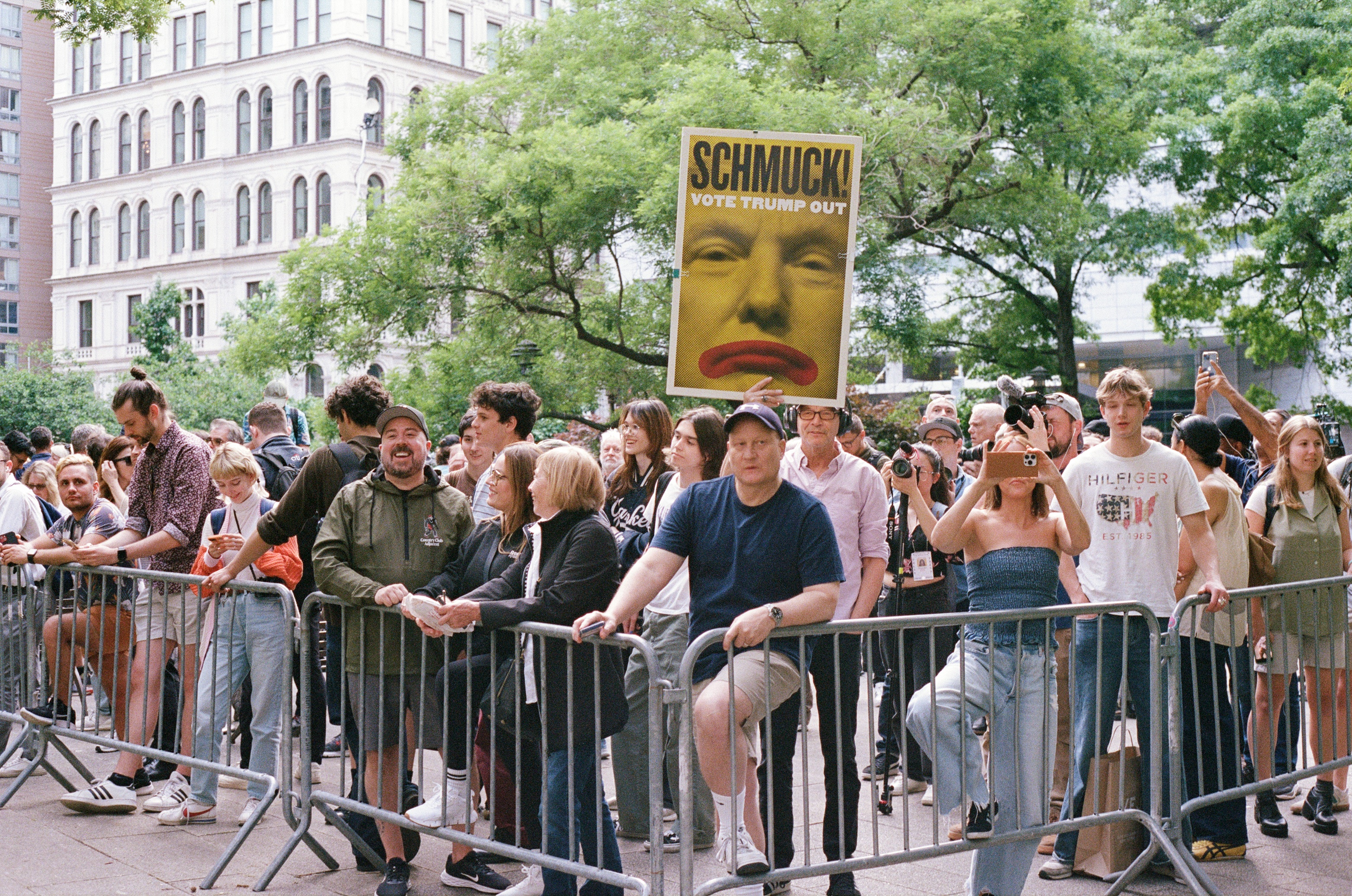
What looks like an anti-Trump crowd gathers moments after news of the jury’s guilty verdict. An apparent pro-Trump crowd (judging by some of the signs and clothing) gathered on the opposite side of the park. I was reminded of seating arrangements at a wedding, in which one side sits for the bride and the other for the groom. But in this case, the two sides were separated by metal barricades.
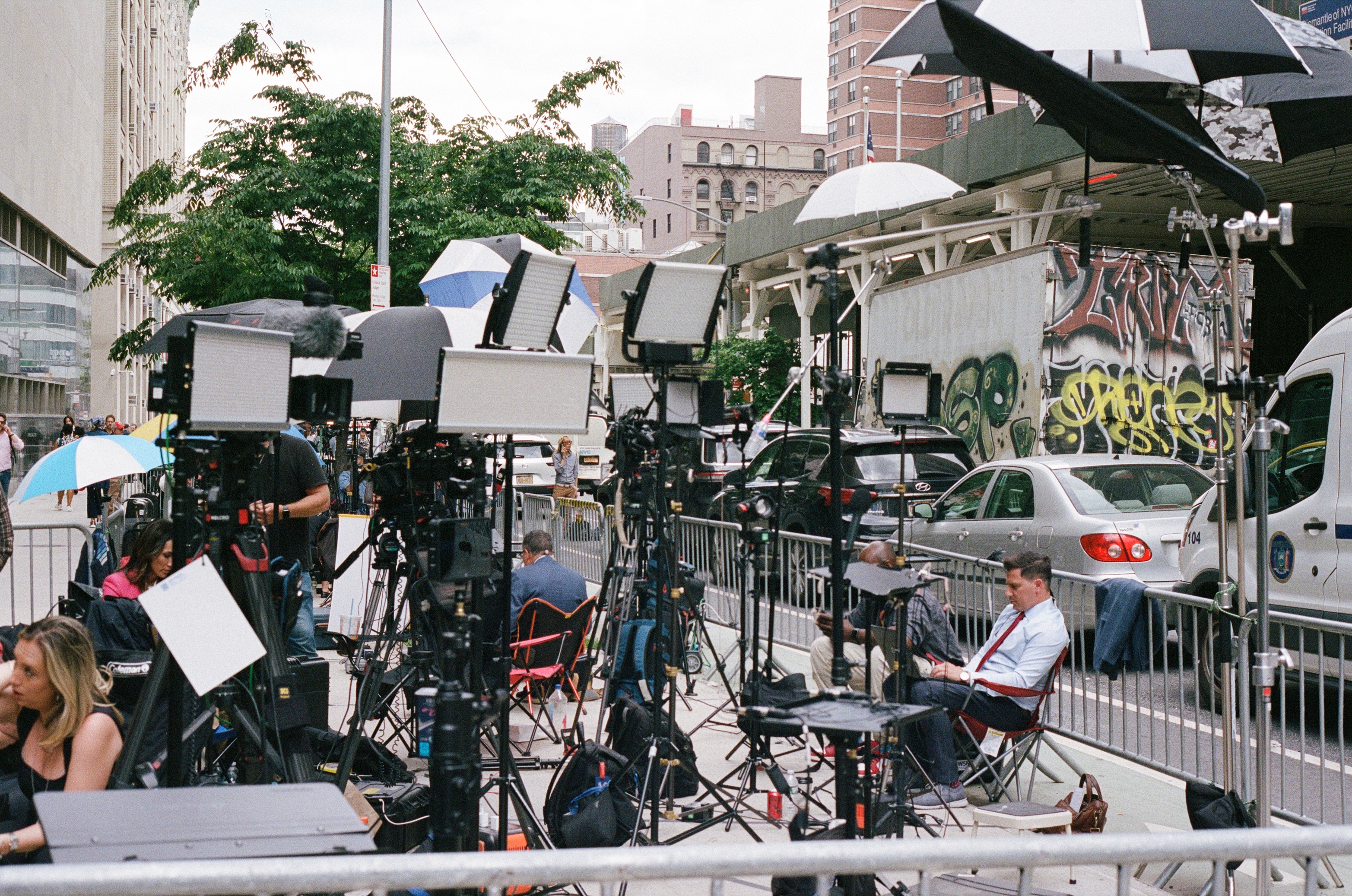
The sidewalk across from 100 Centre street was a perpetual jungle of lights, cameras, and overworked tech crews.
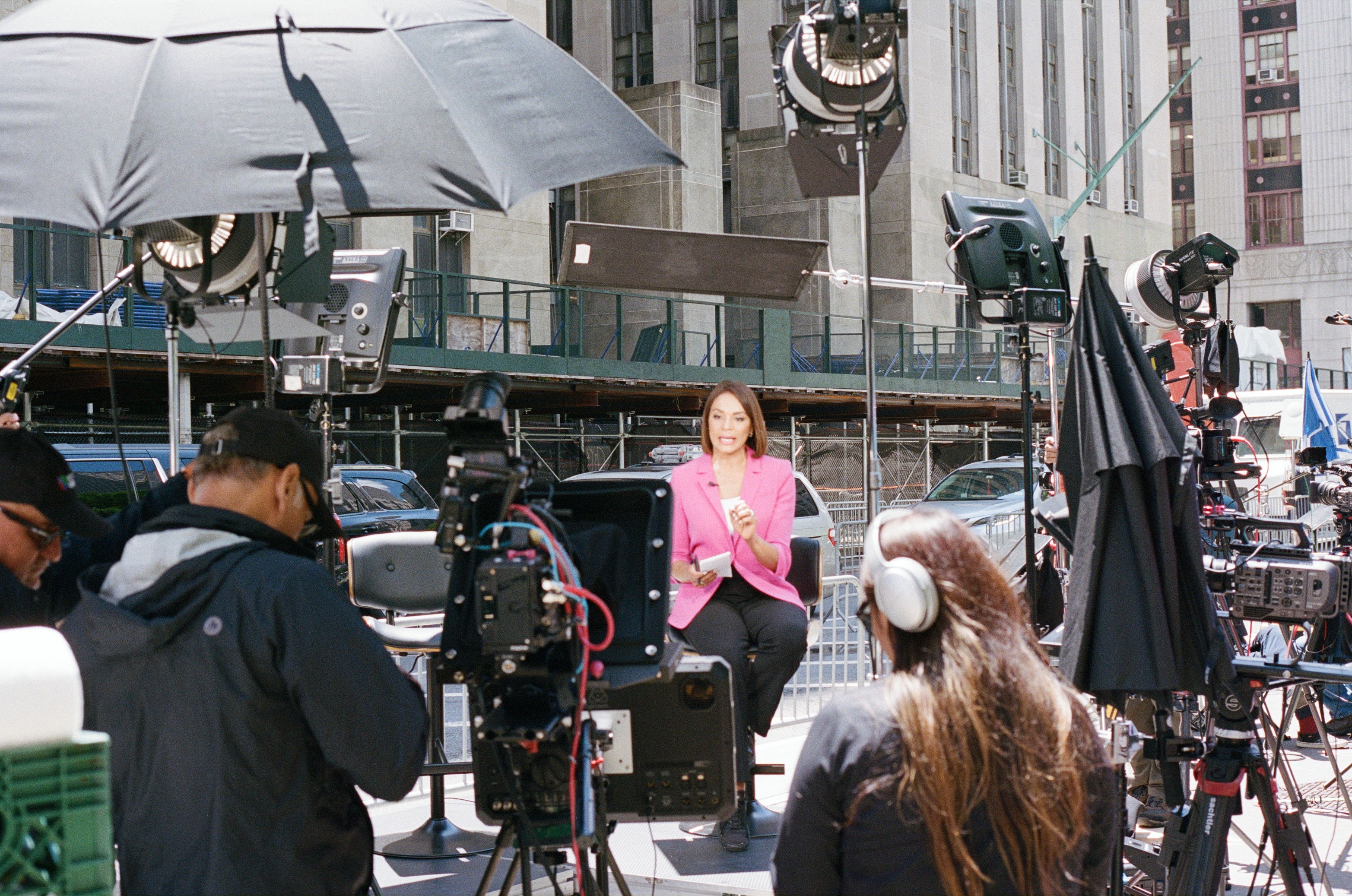
Here, one newscaster broadcasts live from prime sidewalk real estate, in a spot directly across from the doors of the courthouse. Umbrellas were an essential part of any sidewalk setup, key to diffuse the harsh sunlight and protect precious equipment—and precious anchors—from the elements.

Andrew Giuliani, son of Rudy Giuliani and reporter for Real America’s Voice during the trial, was also a regular fixture. He was often seen livestreaming from the press line, giving interviews, or talking on his phone.
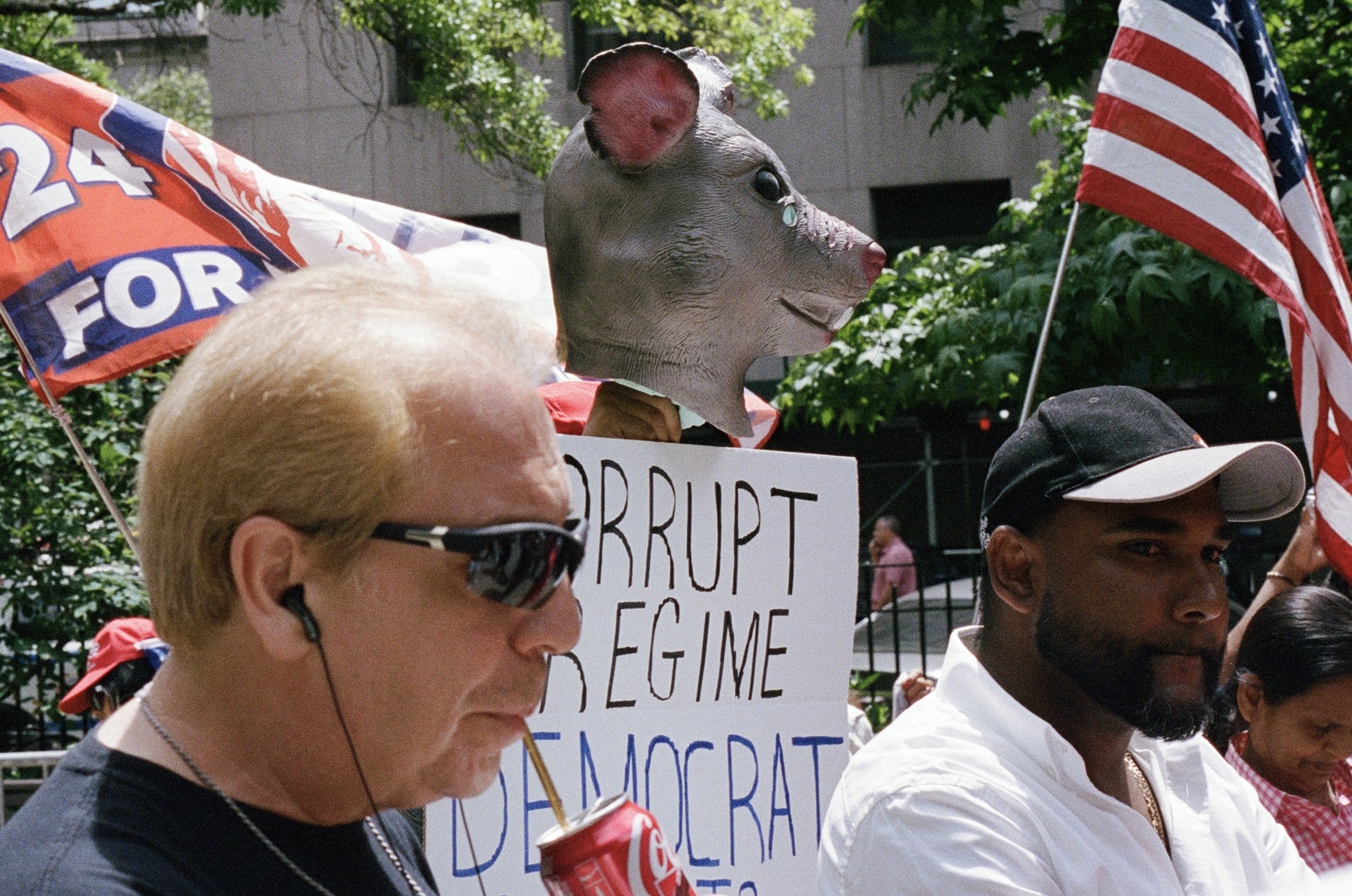
Many protest signs were creative, and some even verged on the theatrical.
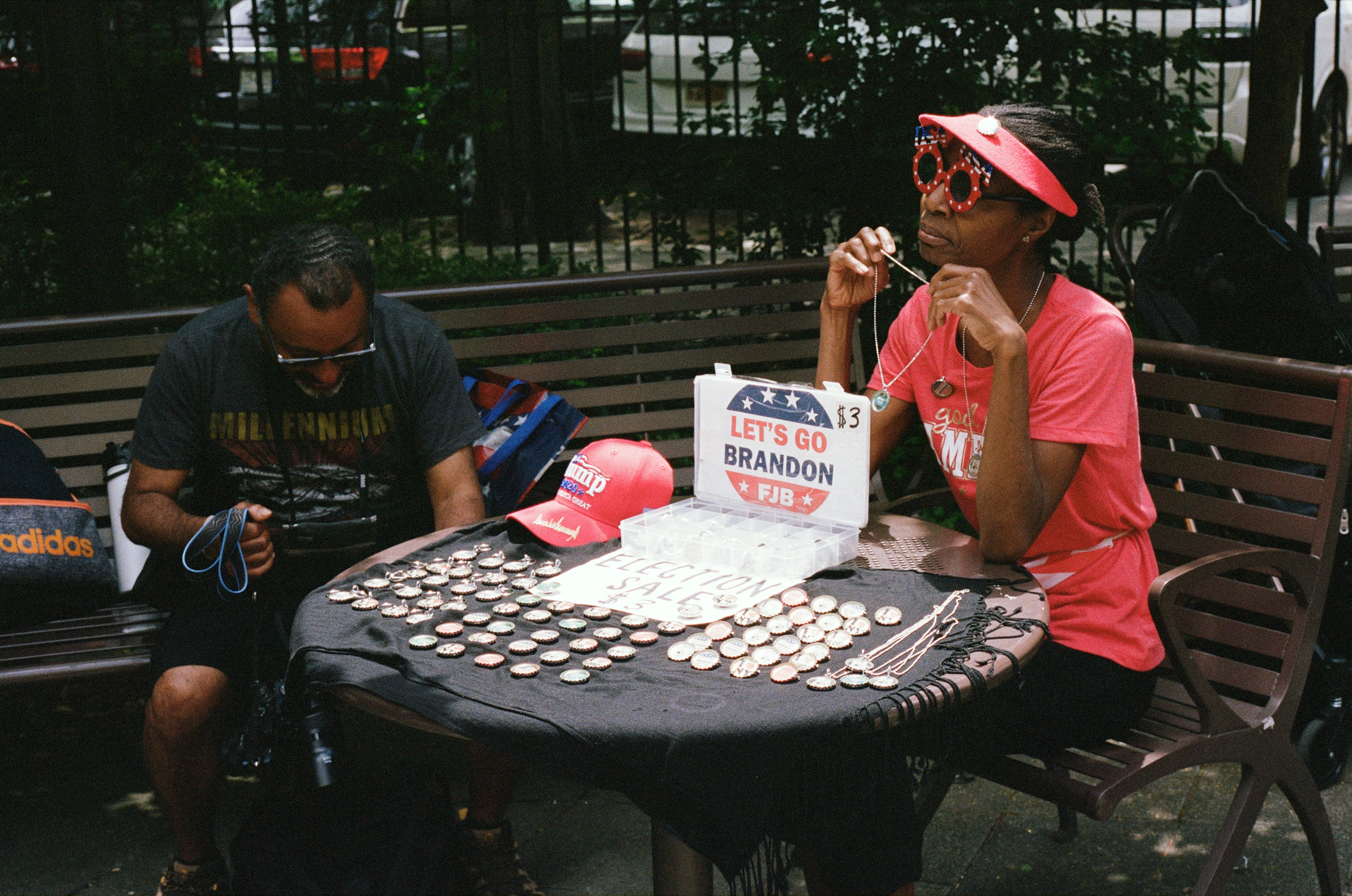
Never letting a good crisis go to waste, several New Yorkers sold pins and other political paraphernalia in the park. A small economy bloomed, and the indomitable entrepreneurial spirit of America marched on.
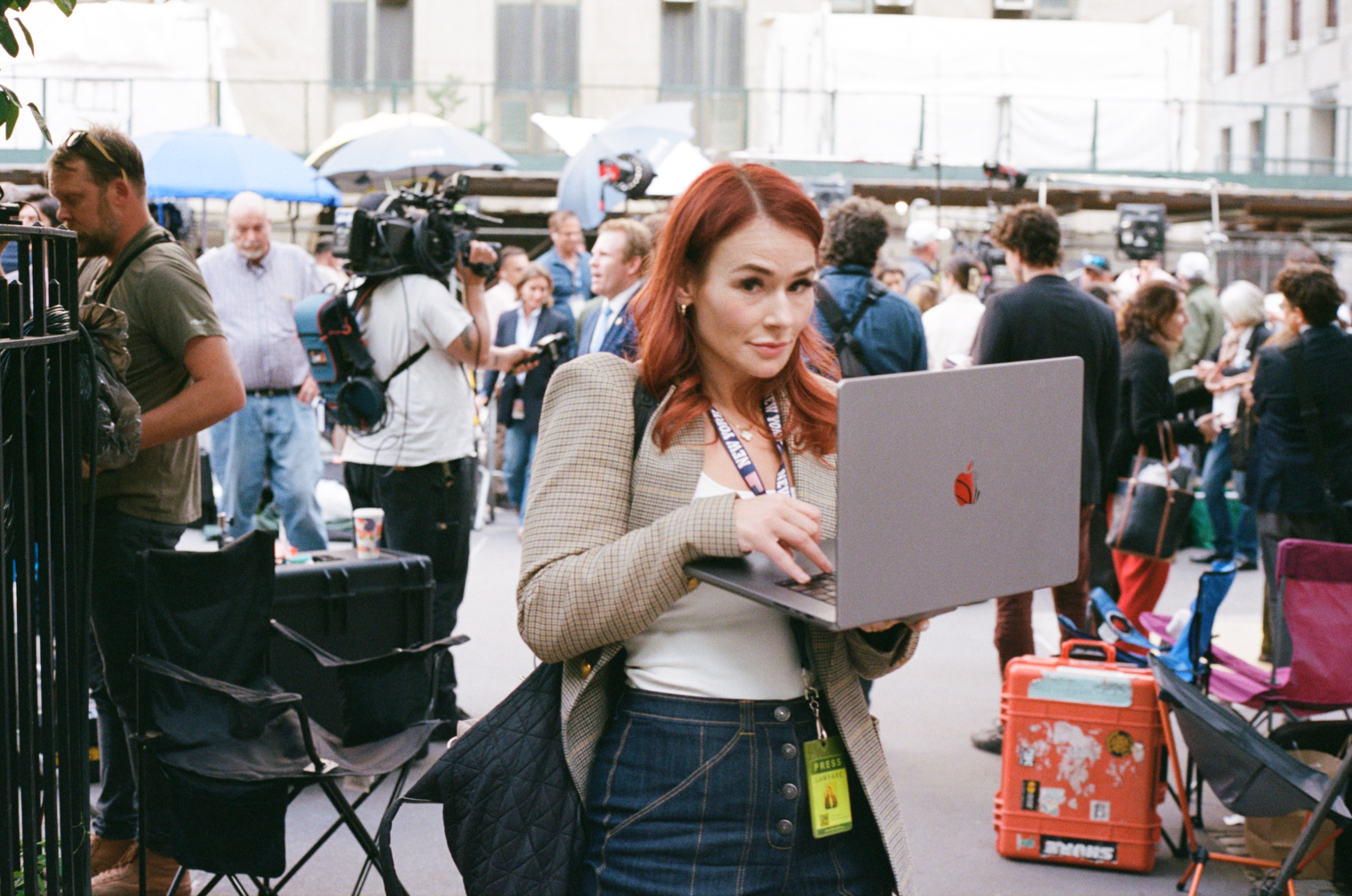
Lawfare’s very own Anna Bower holds a laptop aloft, trying to find any flat service that could serve as a temporary desk. The trial’s many intrepid reporters worked, ate, and rested anywhere they could: some sat cross-legged on the ground with their laptops, while others gave radio interviews from bathroom stalls.
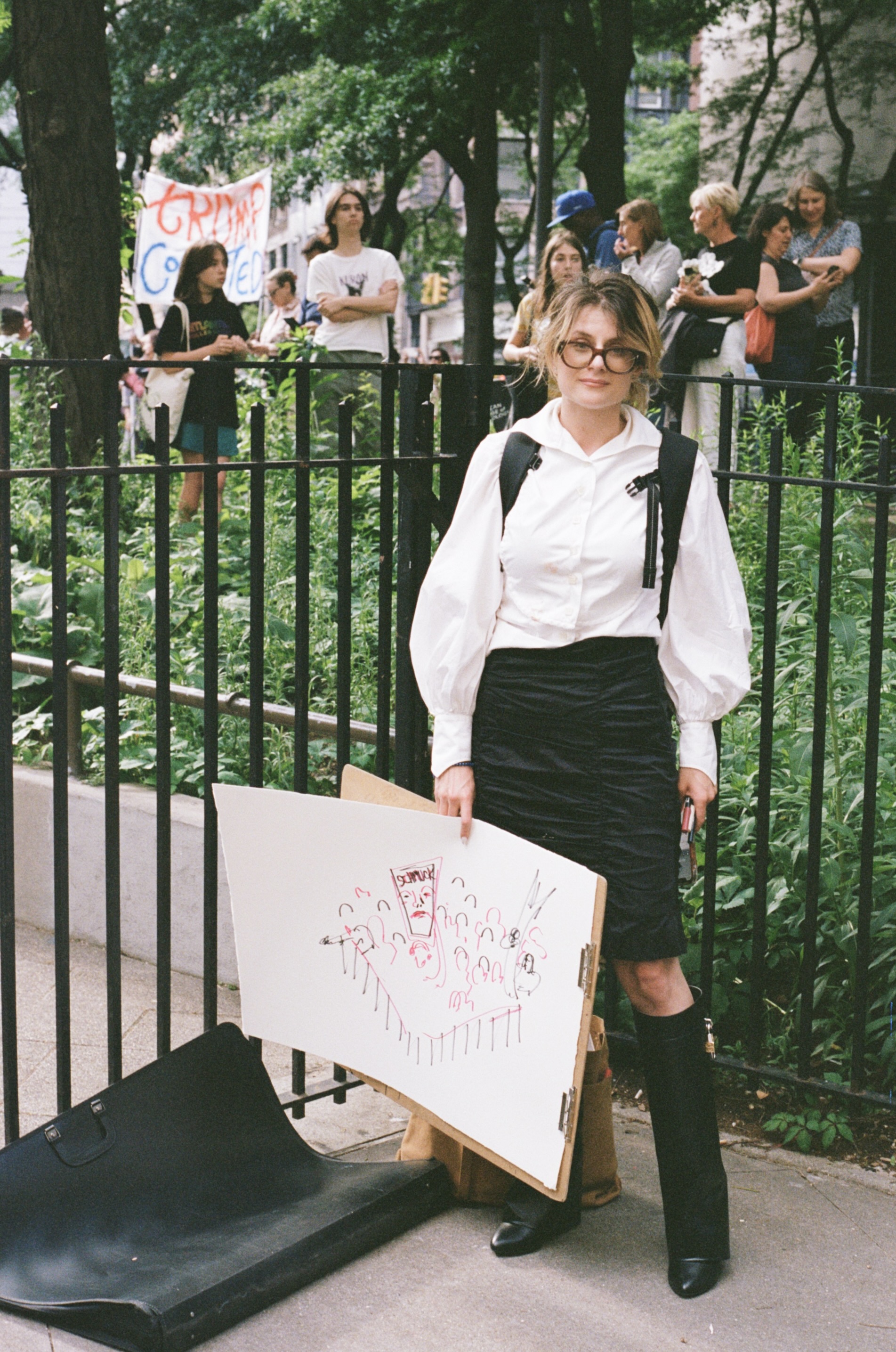
Isabelle Brourman, one of the trial’s courtroom sketch artists, poses outside the courthouse moments after the jury read their verdict.
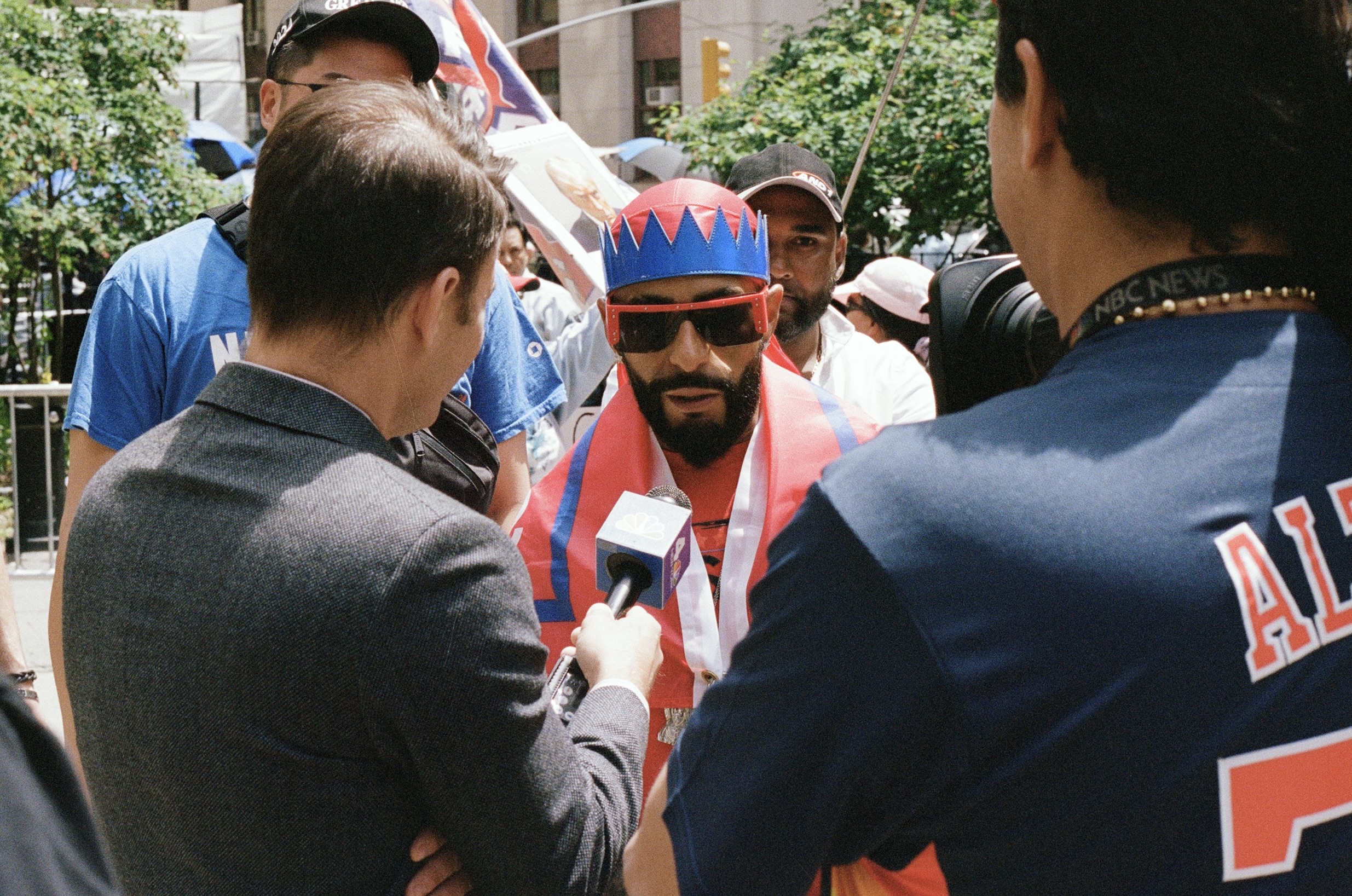
Reporters fanned out across Collect Pond Park, sticking a microphone in front of basically anyone willing to talk. Many protesters got their 15 minutes and then some.
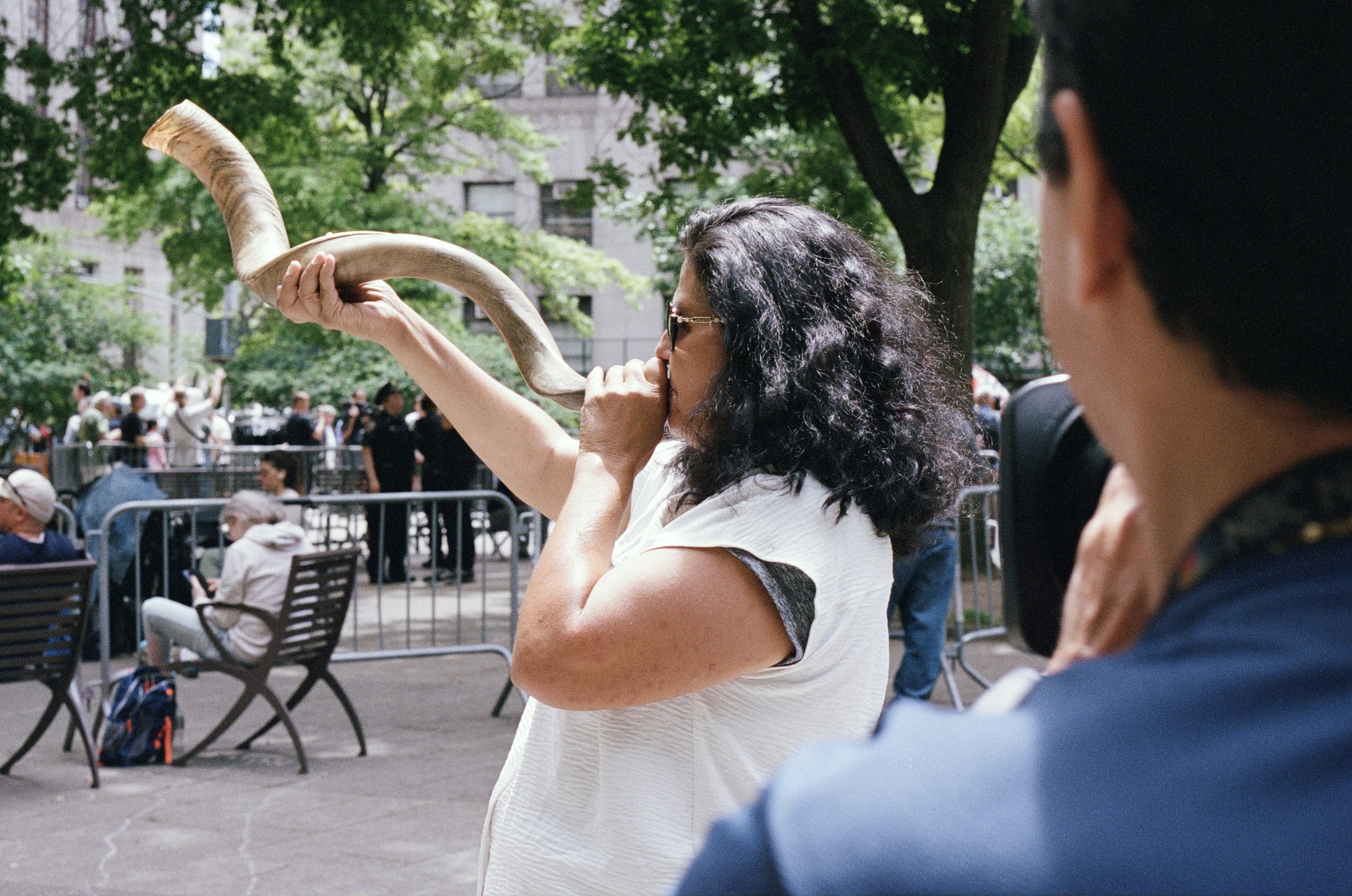
Some protesters had explicitly religious messages or iconography. Here, a woman blows a shofar, a musical ram’s horn typically blown at certain synagogue services. Another repeat protester was a man who carried a large metal crucifix and a loud bell that swung from his belt.
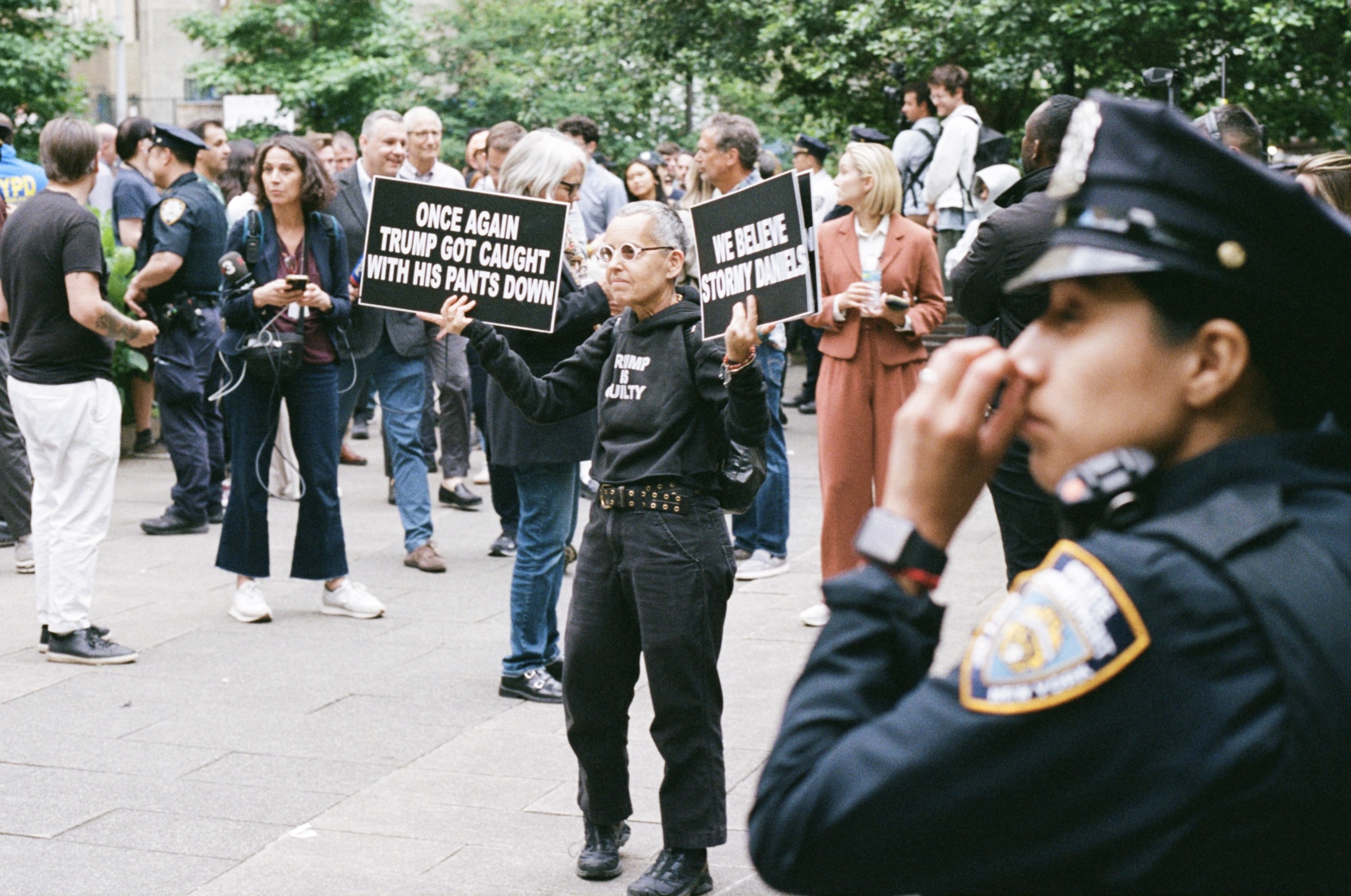
A protester offers support for Stormy Daniels, one of the trial’s many witnesses. Throughout the proceedings, several protesters held up informed and highly specific signs. One protester carried a sign that read, “WHY WON’T BLANCHE LET SCHILLER TESTIFY”—a reference to the absence of Trump’s bodyguard, Keith Schiller, who was present during much of the narrative uncovered at trial.
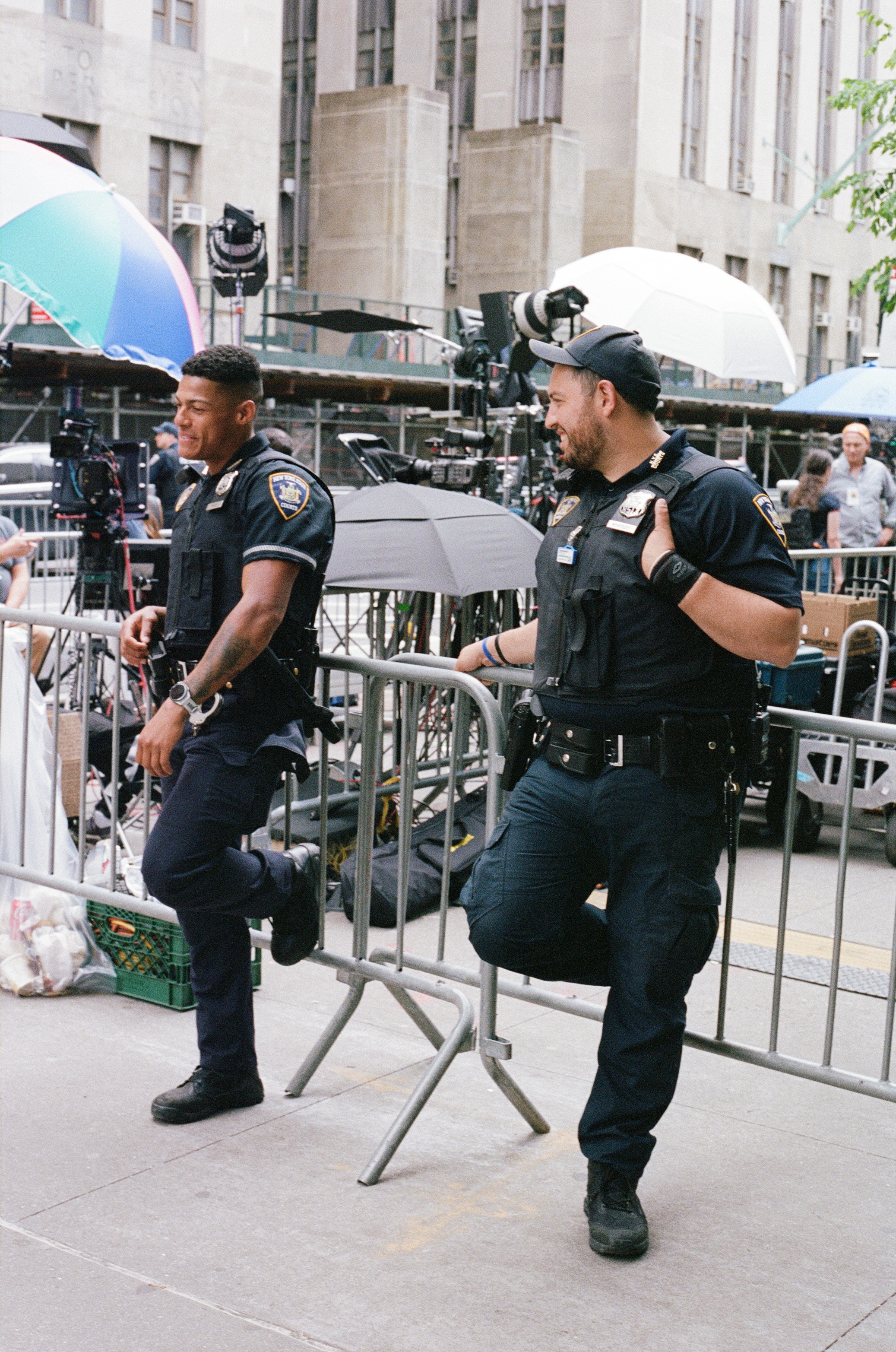
The New York State Court Officers ran point on security during the trial. It was no small task to coordinate with the Secret Service and other security details of various VIP guests who floated in and out of the proceedings, which included several members of Congress and Trump’s family.
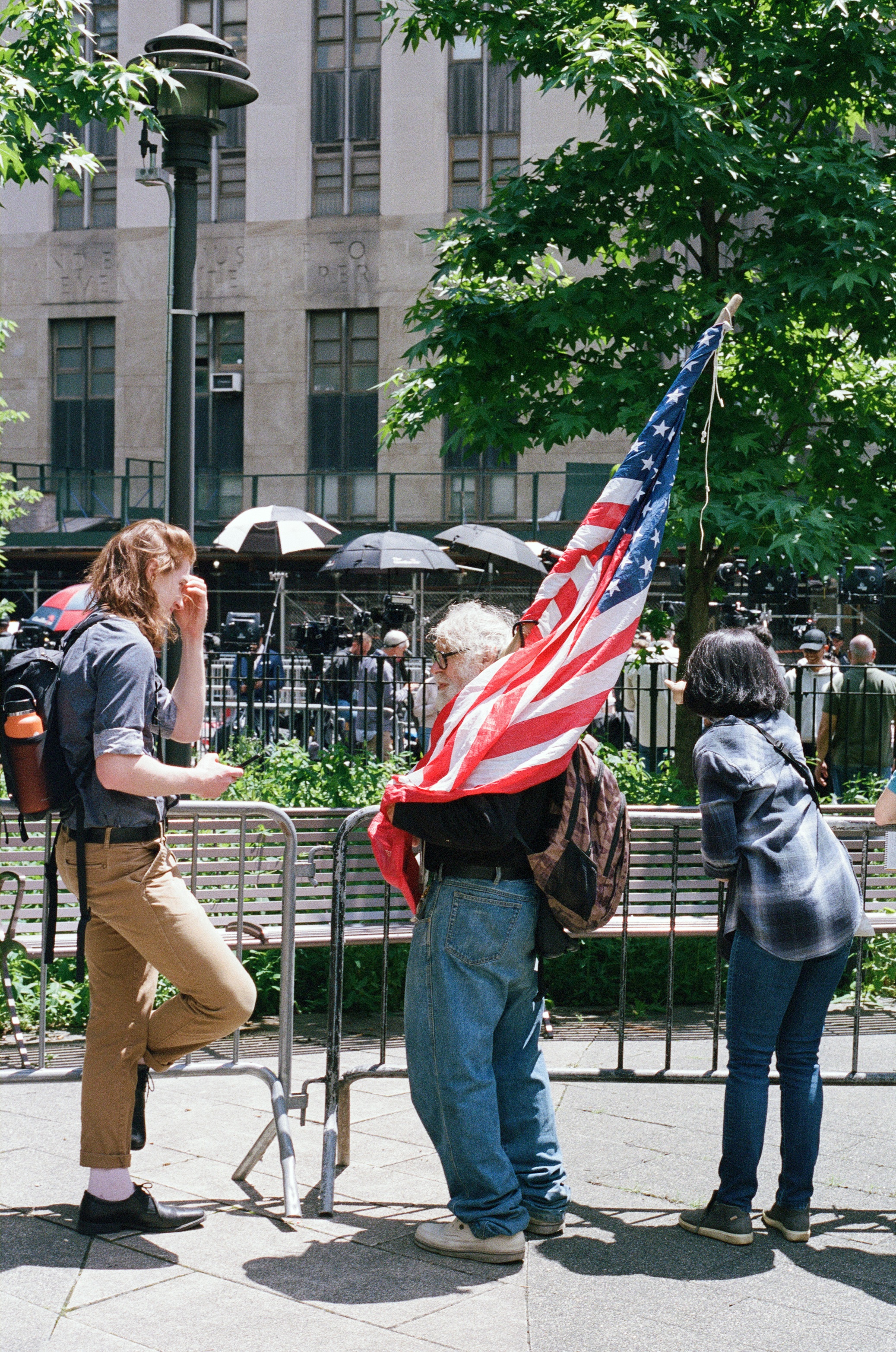
A protester drapes himself in an American flag. It was unclear whether he supported Trump or not. In all of its seediness, its tabloid-ready subplots, and its made-for-TV moments, the trial felt distinctly New York—and above all, distinctly American.
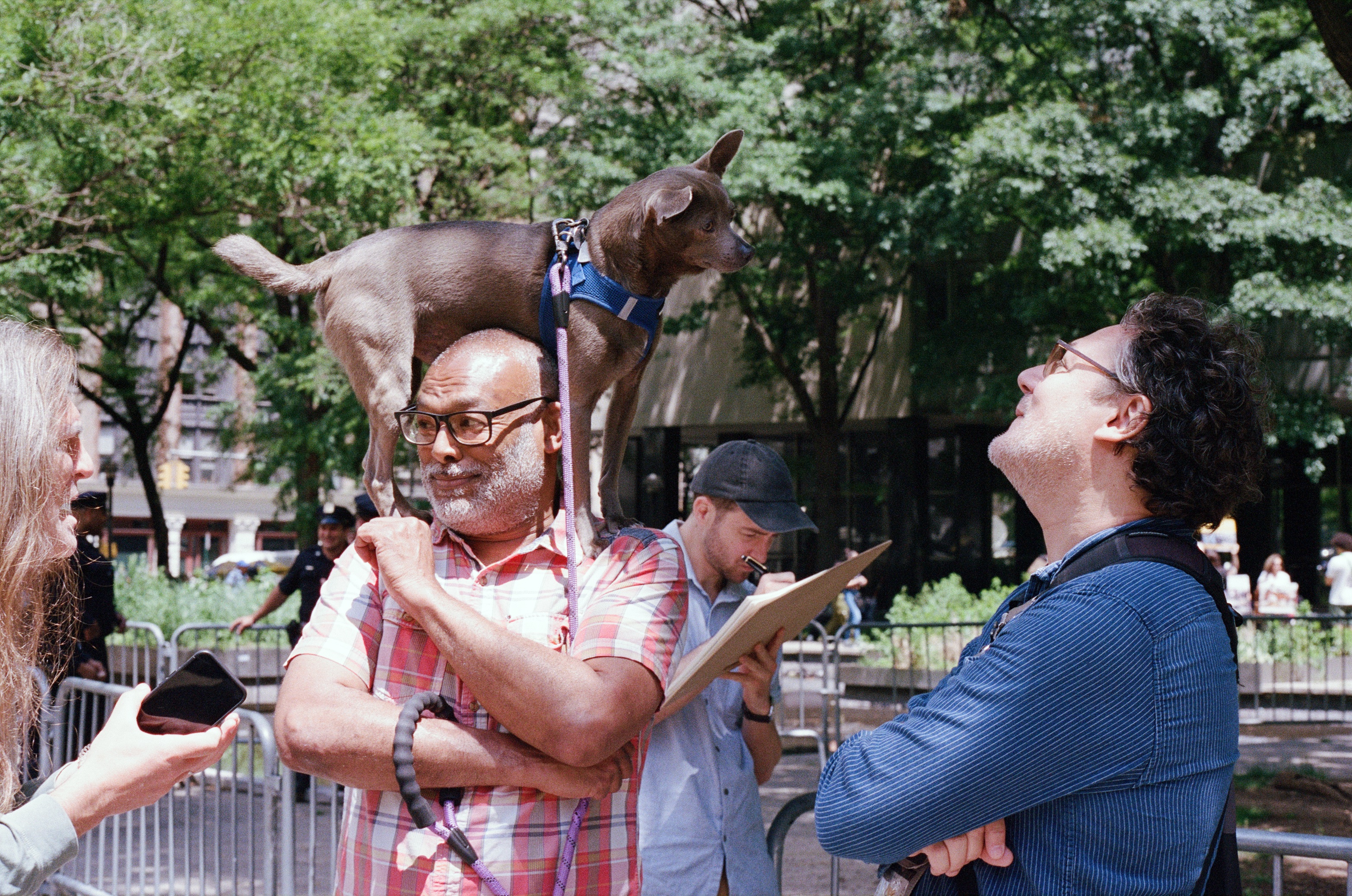
Of course, it wasn’t all politics outside the courthouse. I hope all Americans can come together and agree: this is an adorable dog.

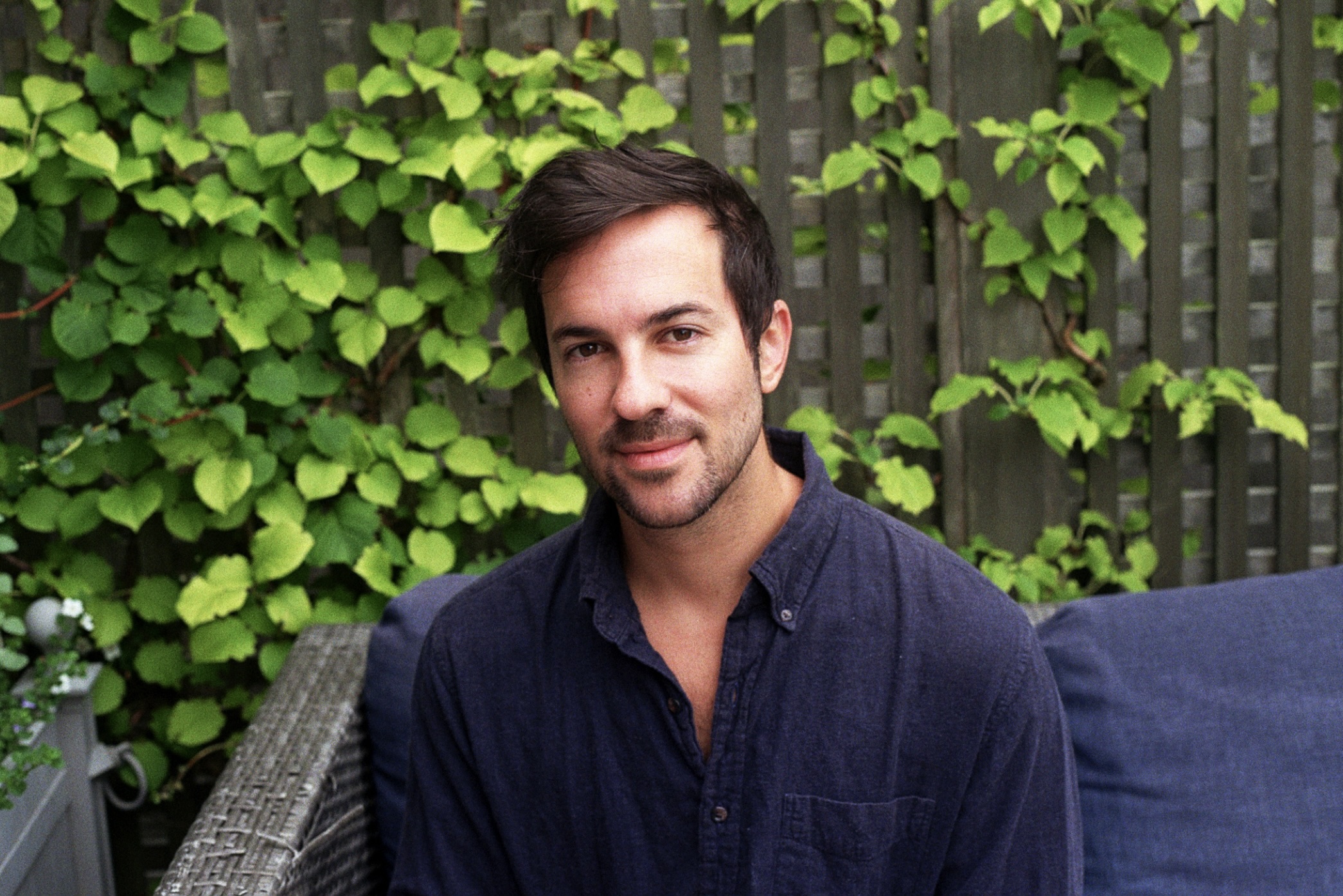

.jpg?sfvrsn=676ddf0d_7)
